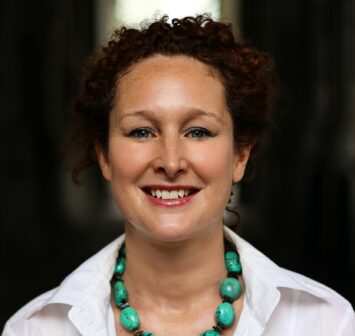There was a time when the real estate sector focused on building walls and balancing books. It still is, but one of the many items rising up the agenda – especially during these times of the pandemic – is health; in the workplace, at home, and in the community.
“We are witnessing a paradigm shift in how the real estate industry sees health,” says Joanna Frank, president & CEO of the Center for Active Design (CfAD), a non-profit organisation headquartered in New York City’s Wall Street.

The real estate industry realises that it has the power to affect what people think, how they behave and who they trust”– Joanna Frank, Center for Active Design
“This comes as the real estate industry realises that it has the power to affect what people think, how they behave and who they trust,” says Frank, whose mission at CfAD is to make health as important as any other aspect of real estate investment in the underwriting process.
When we talk about health, we are talking about a holistic approach – about all aspects of physical, mental and social health – Frank
Mental health is of particular concern at present, with a third of adults in the US saying that their mental health had suffered during the pandemic, and around a quarter of adults in France and the UK.
All aspects of health are impacted by our physical surroundings, from where we work to where we live, all the time, whether we know it or not – Frank
“The need [to consider health]has not changed. It is the understanding of the need that is changing. All aspects of health are impacted by our physical surroundings, from where we work to where we live, all the time, whether we know it or not,” explains Frank, who also took part in the MIPIM Connect webinar, The Role of Real Estate in Improving Health.
Fitwel – designed to optimise buildings to support health
CfAD operates Fitwel, a leading certification system designed to optimise buildings to support health. Launched globally in 2017, the Fitwel scorecards cover multiple building types, from the workplace to the home, as well as sites, including industrial parks, neighbourhoods and larger urban districts, together with the spaces in-between buildings.
Global public health lies at the origins of the system, with the CfAD tapping into over 5,600 academic papers on the subject – a key component of the strategy initiated by the US Centers for Disease Control & Prevention and US General Services Administration, which created the Fitwel Standard.
We are able to bring this incredibly rich, deep body of evidence coming out of public health to the real estate industry, and in almost every conversation this creates a ha-ha moment – Frank
How trust is built and destroyed by the environment
To improve health at a building level, Joseph Allen of the healthy buildings programme at the Harvard TH Chan School of Public Health and John Macomber of Harvard Business School have identified nine ‘foundations’: ventilation, air quality, thermal health, moisture, dusts & pets, safety & security, water quality, noise, and lighting & views.
In an article in the Harvard Business Review, they quote an analysis of sick leave data for over 3,000 workers across 40 buildings that found that 57% of all sick leave was attributable to poor ventilation.
Trust is essential. No one is going to willingly make that jump from working at home to working in the office until they trust that their workplace is a better place to work than their home – Frank
When it comes to social health on a, research carried out jointly by CfAD and UC Berkeley shows that neighbourhood level the level of trust by citizens in local government falls 11 per cent if a green area in the public realm is not well kept, compared with a rise of 8 per cent if it is.
Building trust helps to change attitudes and attitudes change behaviour, says Frank. “Covid has been a lesson in trust,” she adds. “Trust is essential. No one is going to willingly make that jump from working at home to working in the office until they trust that their workplace is a better place to work than their home.”
The S in ESG: why real estate investors are interested
The interest in health from the real estate industry goes beyond building management. “Promoting health by using evidence-based strategies helps investors meet the ‘S’ in their ESG metrics. This allows health to be part of an ESG strategy,” says Frank.
That conversation with investors has shifted to one of, how are we as investors protecting the health of our occupants within our portfolio? – Frank
Before Covid, recounts Frank, investors were focused on how the Fitwel certification improved returns. “Now, that conversation with investors has shifted to one of, how are we as investors protecting the health of our occupants within our portfolio? That is a big shift,” says Frank.
Health on a neighbourhood level
On a wider level, it is about prioritising health in the design and development of urban areas, says Frank. “Our cities reflect what we prioritise and we have prioritised cars for the last 50 years. We have given most of our public space to this ‘box on wheels’, and the way we move around is optimised for 40mph.”
Instead, prioritising health is about ensuring that everything is in walking distance within a neighbourhood. “Not only is it good for us to walk for our physical health, but those casual interactions with other people as we walk down the street benefit our mental health,” says Frank, who points out that social isolation has been proved to be at least as harmful as physical inactivity.
We know what allows people to thrive… access to nature allows people to thrive, and that does not mean we all have to live next to a wood – Frank
It’s also about access to green space. “We know what allows people to thrive… access to nature allows people to thrive, and that does not mean we all have to live next to a wood; it’s about sitting on a park bench next to a tree, maybe in a tiny planting strip in the middle of a city,” says Frank.
“People don’t behave differently because of the country they live in. Behaviour is behaviour. Fundamentally we all react the same way to a tree.”
Healthy housing for all: focus on the UK
Andrew Raven is director for urban design at Savills. “Health and wellbeing is vital to get right,” he says.

“It is about designing ‘permeable’ neighbourhoods where people can walk, cycle or take public transport to local services and facilities, whether a school, a park, a sports pavilion or allotments.”
Health and wellbeing is about designing ‘permeable’ neighbourhoods – Andrew Raven, Savills
However, he adds: “To make a community or an urban area work, it is absolutely necessary to include affordable housing as part of the mix.”
Raven cities the example of Oxford, the least affordable place to live in the UK. Here, house prices are nearly 11 times annual gross average earnings, while key workers are essential for the smooth workings of the local economy.
Savills is currently advising on Barton Park, the North Oxford Triangle (near Oxford Parkway station) and the South Oxford Science Village, all on the edge of Oxford, and where some 30-40 per cent of the 5,000+ homes will be affordable.
The vision of Barton Park, which won it a NHS status of Healthy New Town, is that all residents have “equal opportunity to good physical and mental health, and good health outcomes”. Health is a central part of the scheme. The South Oxford Science Village adds regeneration benefits, with affordable housing enabling key workers access to jobs within walking and cycling distance. Both schemes include permeable, walkable neighbourhoods incorporating plenty of green space.
The role of the NHS in the UK
To make urban areas walkable, they have to be compact, says Raven. This is achieved by the efficient use of land through good design.
His views are echoed in Design, Deliver & Manage, part of the Putting Health into Place series by the UK’s National Health Service (NHS), together with other partners. The report calls for places that are “compact, walkable and mixed-use and have a distinct identity”.
This July, NHS England also released a new design toolkit, Building for a Healthy Life, backed by Homes England, the UK government’s “housing accelerator” in England. The toolkit covers improved walking, cycling and public transport links, carbon reduction and better air quality.
Master plans should be based on an assessment of local health and care needs, with the creation of integrated neighbourhoods based on ‘tenure neutral’ housing and well-defined public spaces” says the toolkit.
This new guidance updates Building for Life 12 (B4L12), which Homes England requires developers to use as part of the tender process for purchasing land.
For residents to take to walking, cycling or public transport, behaviour needs to change – and first attitudes, but at least we now know that the real estate sector has the power to do this.



